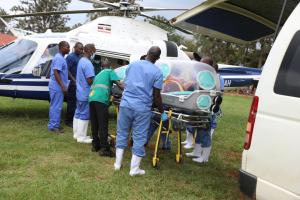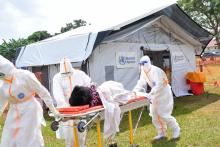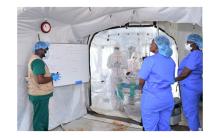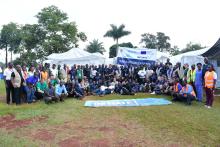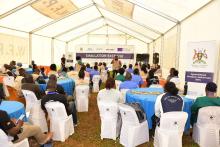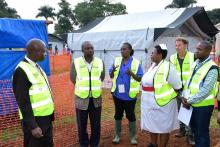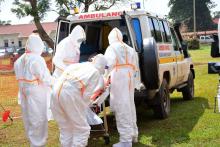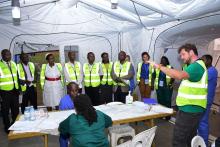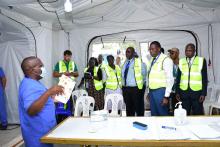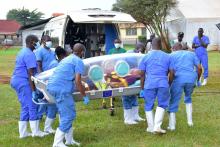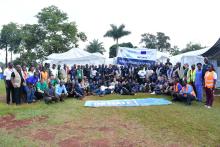Uganda conducts filovirus full-scale response simulation exercise for the national Emergency Medical Team
Jinja, Uganda – The Ministry of Health, with support from the World Health Organization (WHO) through funding from the European Union's Directorate-General for European Civil Protection and Humanitarian Aid Operations (DG-ECHO), has successfully concluded a weeklong full-scale simulation exercise aimed at strengthening Uganda’s emergency health response capabilities.
Held from 14–18 July 2025 in Jinja City, the exercise focused on the use of the innovative Infectious Disease Treatment Module (IDTM) for managing viral haemorrhagic fevers, including Ebola Virus Disease (EVD). The simulation tested the ability of Uganda’s National Emergency Medical Team (nEMT) to rapidly deploy and operate the IDTM during a simulated outbreak.
The exercise was designed and implemented under the INITIATE² project, a global partnership co-managed by WHO and World Food Programme (WFP). Other partners in the simulation exercise include University Hospital Tübingen, Médecins Sans Frontières (MSF), UNICEF, the Makerere University Infectious Diseases Institute, and Africa Centers for Disease Control.
“Public health emergencies can quickly overwhelm the local health systems, necessitating additional support. Fortunately, Uganda has built the national EMT consisting of health workers from various parts of the country, who understand the local context and are readily deployable to support affected communities,” said Dr. Charles Olaro, Director General Health Services, Ministry of Health.
Seventy-five EMT members, along with health workers from the Uganda People’s Defense Forces (UPDF) and Uganda Police Force (UPF), participated in the simulation. The scenario replicated the detection, investigation, and response to a localized Ebola outbreak and included practical exercises in optimized clinical care, infection prevention and control, water, sanitation, and hygiene (WASH), logistics, psychosocial support, and safe and dignified burials.
A critical component of the simulation was testing the international medical evacuation protocol, coordinated by WHO teams in Uganda, the African Region, and Geneva. The Uganda Police Air Wing supported the air evacuation using an epishuttle device.
“This simulation provided a realistic platform for testing field coordination, clinical operations, logistics, and inter-agency collaboration under emergency conditions,” said Dr Kasonde Mwinga, WHO Representative to Uganda. “It has also enabled hands-on capacity building for Uganda’s Emergency Medical Team.”
The national EMT, first established during the COVID-19 pandemic in 2021 with WHO support, currently includes 178 trained health professionals. The team has since responded to outbreaks such as Ebola, mpox and measles. In July 2024, the Ministry of Health approved a national EMT roadmap to guide further capacity building, aligned with the WHO global EMT initiative.
The simulation exercise underscored the importance of standardized protocols and the need for teams to be regularly trained on them. It also highlighted the logistical gaps for national Emergency Medical teams, and the importance of collaborations in addressing these challenges. The success of this simulation highlights Uganda’s growing leadership in health emergency preparedness and the power of global collaboration in strengthening health systems.
